News
Best Paper Awarded at MICCAI 2012
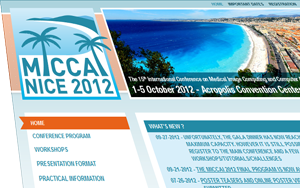 Congratulations to Suyash Awate, Peihong Zhu and Ross Whitaker whose paper has been awarded "Best Paper" at the MICCAI workshop on Multimodal Brain Image Analysis. Winning papers are chosen by the organisers based on relevance, novelty and scientific contribution.
Congratulations to Suyash Awate, Peihong Zhu and Ross Whitaker whose paper has been awarded "Best Paper" at the MICCAI workshop on Multimodal Brain Image Analysis. Winning papers are chosen by the organisers based on relevance, novelty and scientific contribution. S.P. Awate, P. Zhu, R.T. Whitaker. "How Many Templates Does It Take for a Good Segmentation?: Error Analysis in Multiatlas Segmentation as a Function of Database Size," In Int. Workshop Multimodal Brain Image Analysis (MBIA) at Int. Conf. MICCAI, Lecture Notes in Computer Science (LNCS), Vol. 2, pp. 103--114. 2012.
Tolga Tasdizen Awarded NSF CAREER Award
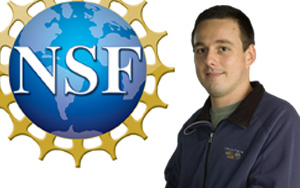 Congratulations to SCI Faculty member and USTAR Associate Professor of Electrical and Computer Engineering Tolga Tasdizen who was recently awarded an NSF CAREER award for his proposal "Deep sparse dictionary context models and their application to image parsing and neuron tracking for connectomics".
Congratulations to SCI Faculty member and USTAR Associate Professor of Electrical and Computer Engineering Tolga Tasdizen who was recently awarded an NSF CAREER award for his proposal "Deep sparse dictionary context models and their application to image parsing and neuron tracking for connectomics". ImageVis3D 2.1.1 and Mobile Universal 4.0 Released
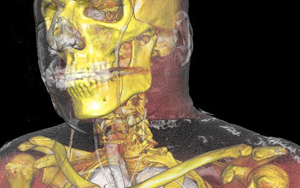 The ImageVis3D team is proud to announce the release of ImageVis3D 2.1.1.
The ImageVis3D team is proud to announce the release of ImageVis3D 2.1.1. DOWNLOAD NOW
ImageVis3D is a desktop volume rendering application which was designed to visualize large data. Support is available for multiple rendering modes, such as 1D and 2D transfer functions, isosurface rendering, as well as specialized modes such as MIP and slice views. On modern systems, ImageVis3D's GPU-accelerated rendering delivers incredible performance, while compatibility options exist to allow ImageVis3D to perform adequately on older systems.
EpiCanvas Publication Awarded 1st Place Biosurveillance Article
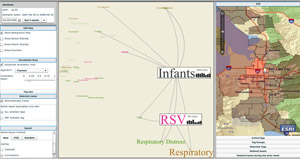 Congratulations to Yarden Livnat and Nathan Galli, et. al. whose paper received the 1st place Award for Outstanding Research Article in Biosurveillance in the Scientific Achievement Category by the International Society for Disease Surveillance (ISDS). This paper describes the development of a new software prototype designed to explore infectious disese data in an interactive visual way that will allow public health professionals to find spacial and temporal correlations, a kind of "disease weather map."
Congratulations to Yarden Livnat and Nathan Galli, et. al. whose paper received the 1st place Award for Outstanding Research Article in Biosurveillance in the Scientific Achievement Category by the International Society for Disease Surveillance (ISDS). This paper describes the development of a new software prototype designed to explore infectious disese data in an interactive visual way that will allow public health professionals to find spacial and temporal correlations, a kind of "disease weather map."
SCIRun 4.6 with BioMesh3D Released
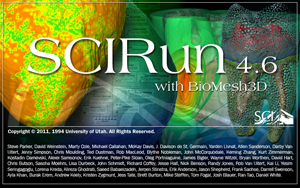 The SCIRun development team is pleased to announce the release of SCIRun 4.6 with meshing tools. SCIRun 4.6 is available as a binary download for Windows and OS X, and as a source download for Linux.
The SCIRun development team is pleased to announce the release of SCIRun 4.6 with meshing tools. SCIRun 4.6 is available as a binary download for Windows and OS X, and as a source download for Linux.Download Now
See also the Release notes.
Chris Johnson Receives the IEEE IPDPS 2012 Charles Babbage Award
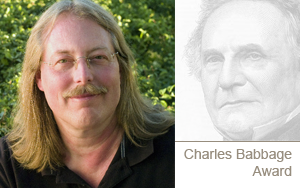 Congratulations to Chris Johnson on receiving the IEEE IPDPS 2012 Charles Babbage Award in recognition of his innovations in the area of scientific visualization and their application to computational biomedicine, engineering, and scientific discovery.
Congratulations to Chris Johnson on receiving the IEEE IPDPS 2012 Charles Babbage Award in recognition of his innovations in the area of scientific visualization and their application to computational biomedicine, engineering, and scientific discovery.Read the full press release from the IEEE Computer Society (pdf).
Learn more about the Charles Babbage AwardCharles Babbage Award
Miriah Meyer Named as Microsoft Research Faculty Fellow
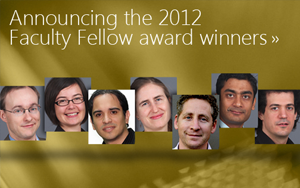 Congratulations to Miriah Meyer who has been selected as one of seven Microsoft Research Faculty Fellows for 2012. The award recognizes innovative, promising new faculty members from research institutions around the world for their advancements in computing research. Miriah will receive her grant at Microsoft’s 2012 Faculty Summit on July 16-17 in Redmond, Washington.
Congratulations to Miriah Meyer who has been selected as one of seven Microsoft Research Faculty Fellows for 2012. The award recognizes innovative, promising new faculty members from research institutions around the world for their advancements in computing research. Miriah will receive her grant at Microsoft’s 2012 Faculty Summit on July 16-17 in Redmond, Washington.Salt Lake Tribune Article
MRL Release CT Arthrogram of Hip Datasets
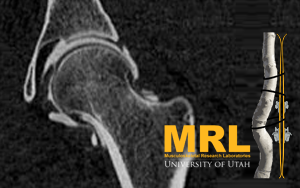 In a recent study, researchers at the Musculoskeletal Research Laboratories (MRL) examined the mechanics of cartilage in the normal hips of 10 healthy adult volunteers. Now they have made the de-identified CT arthrogram datasets available online for other researchers to download. The datasets were acquired as part of a research project on the biomechanics of hip dysplasia (NIH #R01AR053344). Healthy young adults consented to receive a CT arthrogram of one hip joint. The image datasets include the pelvis and proximal femur. One hip joint has been injected with a contrast agent to facilitate delineation of intra-articular cartilage layers. The contralateral hip joint is also visible. The datasets along with details about the subjects, CT scan settings, and image resolution can be found on the MRL Lab Data Archive.
In a recent study, researchers at the Musculoskeletal Research Laboratories (MRL) examined the mechanics of cartilage in the normal hips of 10 healthy adult volunteers. Now they have made the de-identified CT arthrogram datasets available online for other researchers to download. The datasets were acquired as part of a research project on the biomechanics of hip dysplasia (NIH #R01AR053344). Healthy young adults consented to receive a CT arthrogram of one hip joint. The image datasets include the pelvis and proximal femur. One hip joint has been injected with a contrast agent to facilitate delineation of intra-articular cartilage layers. The contralateral hip joint is also visible. The datasets along with details about the subjects, CT scan settings, and image resolution can be found on the MRL Lab Data Archive.For more details see the MRL website - "CT Arthrogram Image Data of the Hip"
FluoRender Image Among Winners of FASEB BioArt Competition
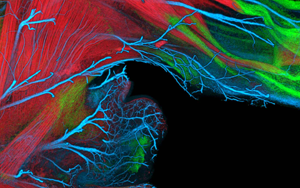 Congratulations to Yong Wan and Charles Hansen, et al on their winning submission to this year's FASEB BioArt Competition
Congratulations to Yong Wan and Charles Hansen, et al on their winning submission to this year's FASEB BioArt CompetitionA. Kelsey Lewis1, Yong Wan1, Mary Colasanto1, Mark van Langeveld1, Ronen Schweitzer2§, Charles D. Hansen1, and Gabrielle Kardon1§
1University of Utah, Salt Lake City, UT, 2Shriners Hospital, Portland, OR, §Society for Developmental Biology
Miriah Meyer Named Top 100 Most Creative People in Business by Fast Company
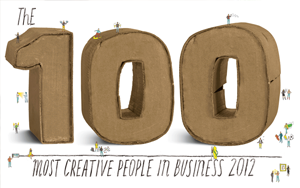 Congratulations to Miriah Meyer, who has been named amongst the top 100 most creative people in business by Fast Company. This honor places her in a rather esteemed and widespread group of individuals ranging from Fortune 500 leaders to music mogals.
Congratulations to Miriah Meyer, who has been named amongst the top 100 most creative people in business by Fast Company. This honor places her in a rather esteemed and widespread group of individuals ranging from Fortune 500 leaders to music mogals.Utah-Led Group Gets $15M from Army to Design New Materials
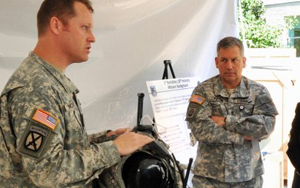 May 7, 2012 – U.S. soldiers are increasingly weighed down by batteries to power weapons, detection devices and communications equipment. So the Army Research Laboratory has awarded a University of Utah-led consortium almost $15 million to use computer simulations to help design materials for lighter-weight, energy efficient devices and batteries.
May 7, 2012 – U.S. soldiers are increasingly weighed down by batteries to power weapons, detection devices and communications equipment. So the Army Research Laboratory has awarded a University of Utah-led consortium almost $15 million to use computer simulations to help design materials for lighter-weight, energy efficient devices and batteries."We want to help the Army make advances in fundamental research that will lead to better materials to help our soldiers in the field," says computing Professor Martin Berzins, principal investigator among five University of Utah faculty members who will work on the project. "One of Utah’s main contributions will be the batteries."
Of the five-year Army grant of $14,898,000, the University of Utah will retain $4.2 million for research plus additional administrative costs. The remainder will go to members of the consortium led by the University of Utah, including Boston University, Rensselaer Polytechnic Institute, Pennsylvania State University, Harvard University, Brown University, the University of California, Davis, and the Polytechnic University of Turin, Italy.




